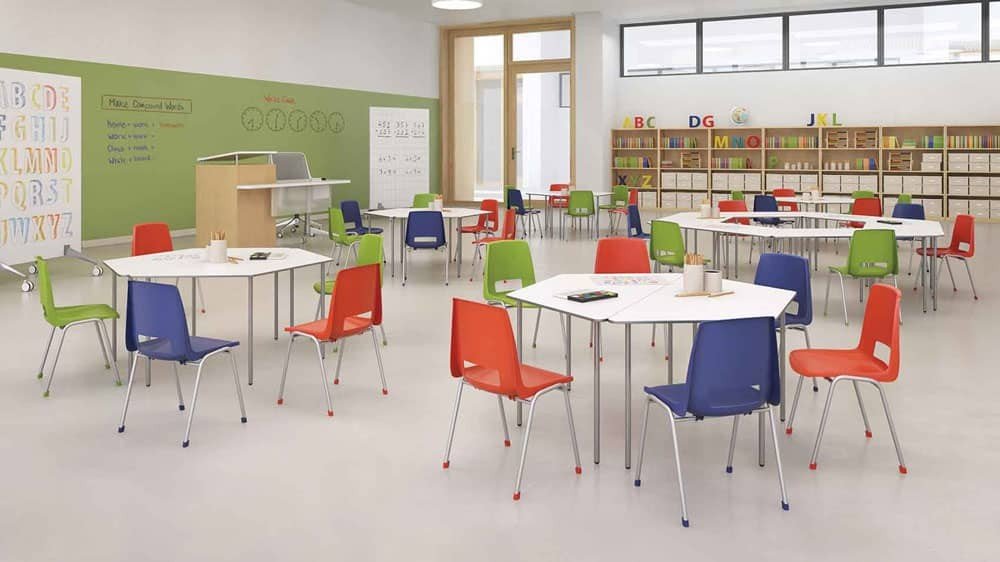
Choosing the right school chairs for kids is a crucial decision that can significantly impact their learning experience. With numerous options available, it’s essential to focus on features that promote comfort, support, and proper posture. In this comprehensive guide, we will explore the key features to look for in kids school chairs, ensuring they are both functional and conducive to a positive educational environment.
Ergonomic Design
One of the most critical features to consider in kids’ school chairs is ergonomic design. Ergonomics refers to how well a chair supports the natural posture of the body, reducing strain and discomfort. Here are some aspects of ergonomic design to look for:
Adjustable Height: Kids grow at different rates, so adjustable height is essential. This feature ensures that the chair can be modified to fit the student’s height, promoting proper posture and comfort.
Lumbar Support: Proper lumbar support is crucial for maintaining the natural curve of the spine. Look for chairs that offer good lower back support to prevent slouching and back pain.
Seat Depth and Width: The seat should be deep and wide enough to accommodate the child’s size comfortably. A well-proportioned seat helps distribute weight evenly and reduces pressure points.
Backrest Angle: A backrest that can be adjusted or has a slight recline can help support the spine’s natural curve, allowing students to lean back comfortably.
Armrests: While not always necessary, armrests can provide additional support for the arms and shoulders. Ensure they are adjustable to suit different arm lengths.
Durability and Material
School chairs for kids should be durable to withstand daily use and rough handling. The material of the chair plays a significant role in its longevity and comfort:
Frame Material: Steel or aluminum frames are strong and long-lasting. They can withstand the rigors of a busy classroom environment better than plastic or wood.
Seat and Back Material: Look for chairs with high-quality, durable materials for the seat and backrest. Polypropylene or high-density polyethylene are excellent choices due to their durability and ease of cleaning.
Easy Maintenance: Chairs should be easy to clean and maintain, as kids can be messy. Materials that resist stains and are easy to wipe down will help keep the chairs looking new.
Safety Features
Safety is a paramount concern when selecting school chairs for kids. Ensuring that the chairs are safe for everyday use can prevent accidents and injuries:
Stable Base: A wide and stable base prevents tipping, which is especially important for younger children who may fidget or lean in their chairs.
Rounded Edges: Chairs with rounded edges reduce the risk of injuries from sharp corners. This feature is particularly important in environments where young children are present.
Non-Toxic Materials: Ensure that the materials used in the chairs are non-toxic and free from harmful chemicals, especially if the chairs are made of plastic or synthetic materials.
Anti-Slip Feet: Chairs with anti-slip feet provide better stability and prevent the chairs from sliding around on smooth surfaces, enhancing safety.
Comfort and Support
Comfortable chairs can enhance students’ focus and productivity. When kids are comfortable, they are less likely to fidget and more likely to stay engaged in their tasks:
Padded Seats and Backrests: While not always necessary, padded seats and backrests can add an extra layer of comfort, especially for longer periods of sitting.
Breathable Materials: Chairs made from breathable materials, such as mesh, can help regulate temperature and prevent discomfort caused by sweating.
Flexible Backrest: A backrest that provides some flexibility can adapt to the child’s movements, offering continuous support and comfort.
Mobility and Storage
In a dynamic classroom environment, mobility and storage features are also important:
Lightweight Design: Lightweight chairs are easier for kids to move and rearrange, fostering a flexible learning environment.
Stackable Chairs: Stackable chairs are ideal for classrooms with limited space. They can be easily stored when not in use, freeing up space for other activities.
Caster Wheels: For older students or specific classroom setups, chairs with caster wheels can offer increased mobility, allowing students to move around easily.
Aesthetic Appeal
While functionality and safety are paramount, the aesthetic appeal of the chairs should not be overlooked. Chairs that are visually appealing can create a more inviting and enjoyable learning environment:
Color Options: Choose chairs available in a variety of colors to match the classroom décor or create a vibrant and stimulating atmosphere.
Design: Modern and attractive designs can make the classroom feel more welcoming and engaging for students.
Cost-Effectiveness
Finally, cost-effectiveness is an important consideration. Balancing quality and budget ensures that you get the best value for your investment:
Durability: Investing in durable chairs may have a higher upfront cost but can save money in the long run by reducing the need for frequent replacements.
Bulk Purchase Discounts: Many suppliers offer discounts for bulk purchases, which can be beneficial for schools needing to furnish multiple classrooms.
Warranty: Look for chairs that come with a warranty to protect your investment. A good warranty can provide peace of mind and ensure that any issues will be addressed.
Conclusion
Selecting the right school chairs for kids involves considering a range of features that contribute to comfort, safety, and durability. Ergonomic design, durable materials, safety features, and comfort are all crucial aspects to evaluate. Additionally, mobility, storage, aesthetic appeal, and cost-effectiveness play significant roles in making an informed choice.
By focusing on these key features, you can ensure that the school chairs you choose will support a productive and positive learning environment. Whether you are a school administrator, teacher, or parent, understanding what to look for in kids’ school chairs can help you make the best decision for the students’ well-being and educational experience. Investing in high-quality, well-designed chairs is an investment in the future of the children who will use them every day.






